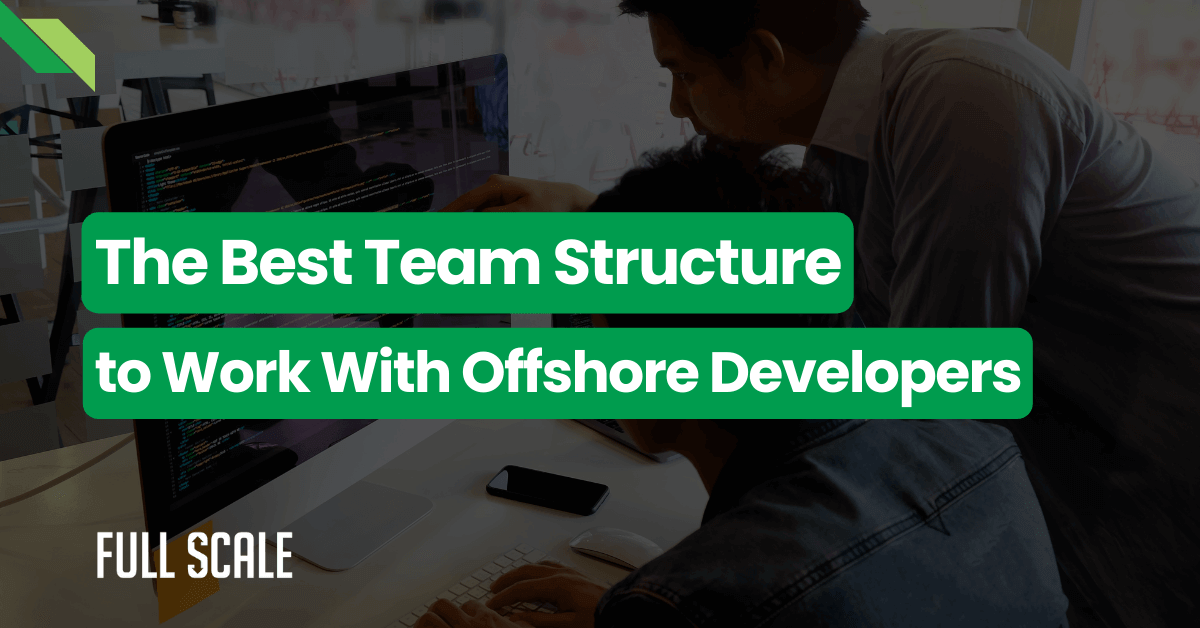one worth hiring.
Full-stack vs. specialist isn’t just a hiring preference. It’s the difference between shipping fast and drowning in technical debt.
Specialists in coordinated teams outperform full-stack developers by 40% in delivery speed. They write better code. They stick around longer.
Modern frontend and backend are too complex for one person to master both. “Full-stack” is a marketing term that sounds efficient but delivers mediocrity.
You don’t need generalists who do everything poorly. You need specialists who collaborate effectively within the right team structure.
What You'll Learn in This Guide
- Why the full-stack vs. specialist debate actually matters for your delivery speed and code quality
- The hidden costs of full-stack developers that inflate your budget by 40-60%
- The coordinated specialist team structure that high-performing companies use
- A 90-day transition plan to move from full-stack chaos to specialist efficiency
- Real data from 60+ companies showing why this team structure works
Reading time: 9 minutes | Everything you need to rebuild your engineering team structure
Why "Full-Stack Developer" Is a Marketing Term
The tech industry sold you a lie. One developer can’t master both frontend and backend in 2025.
Let’s talk numbers. Frontend alone requires mastery of React, state management, performance optimization, and accessibility standards. That’s 40+ hours per week just staying current.
Backend demands microservices architecture, cloud infrastructure, database optimization, and API design. Add another 40+ hours weekly.
The math doesn’t work. You’re hiring someone who’s mediocre at both instead of excellent at one. This directly impacts your software development team structure and its effectiveness.
The Evolution Nobody Talks About
In 2010, full-stack made sense. jQuery plus Rails meant one person could handle everything. Those days are gone.
2025 is different. The React ecosystem alone has more complexity than entire stacks had 15 years ago. Kubernetes, serverless, edge computing—backend isn’t simple anymore either.
Your engineering team structure needs to evolve because technology complexity has exploded. Your hiring strategy needs to catch up.
What “Full-Stack” Really Means
Companies say “full-stack” when they mean “we want one person doing two jobs.” It’s a budget decision disguised as a technical requirement. When I was building my first SaaS company, I made this exact mistake.
Here’s what actually happens:
- You post a full-stack role and wait four months
- The candidates who apply are junior developers calling themselves senior
- You settle for someone who’s okay at frontend and okay at backend
- Six months later, you’re buried in technical debt from both sides
True senior full-stack developers exist. They’re less than 5% of developers, and they cost $200K+. Even then, they specialize once hired because context-switching kills productivity.
According to the 2024 Stack Overflow Developer Survey, 73% of professional developers identify as specialists. The market is telling you something. The full-stack vs. specialist question has already been answered by the people who write code for a living.
The Real Cost of Full-Stack Teams
Full-stack developers cost you more than their salary. The hidden expenses destroy your budget and timeline. Let’s break down what you’re actually paying.
Context-switching between frontend and backend costs 20-30 minutes per switch. Your developer switches 8-12 times daily, according to research from the University of California.
That’s 3-4 hours of lost productivity every single day. You’re paying for eight hours but getting four hours of actual output. This isn’t about the full-stack vs. specialist skill debate—it’s about cognitive science.
"Context-switching costs full-stack developers 3-4 hours of lost productivity every single day. That's why specialists deliver 40% faster with 65% fewer bugs."
— Based on University of California research and Full Scale client data
The Technical Debt Problem
Generalists write functional code, not optimized code. The difference shows up six months later when everything breaks. I’ve seen this pattern with dozens of companies.
Frontend issues include:
- Poor performance that drives users away
- Accessibility violations that create legal risk
- Inconsistent user experience that confuses customers
- Component architecture that doesn’t scale
Backend problems surface as:
- Scalability bottlenecks that crash during traffic spikes
- Security vulnerabilities that expose customer data
- Database queries that slow to a crawl
- API design that frontend developers hate working with
Fixing technical debt costs 3-5x more than building it right the first time. Your “cost-effective” full-stack hire just became your most expensive mistake. This is why getting your team structure right matters more than individual developer costs.
This comparison reveals the real economics of the full-stack vs. specialist decision. Total cost of ownership tells the story that salary comparisons miss. The right engineering team structure pays for itself within six months.
| Metric | Full-Stack Approach | Specialist Team |
|---|---|---|
| Initial Cost | Lower | Higher |
| Delivery Speed | 6-8 weeks per feature | 3-4 weeks per feature |
| Code Quality | Medium | High |
| Post-Launch Bugs | High | 65% fewer |
| Technical Debt | Accumulates fast | Minimal |
| Developer Retention | 60% after 3 years | 95% after 3 years |
| 2-Year Total Cost | Higher | 40% Lower |
The Velocity Myth Destroyed
“But won’t specialists create bottlenecks?” That’s what happens with full-stack developers, not specialists. Let me show you why.
One full-stack developer works sequentially. Frontend, then backend, then integration. Three separate phases for every feature. Context-switching between each phase costs 20-30 minutes minimum.
Two specialists work in parallel:
- Frontend and backend happen simultaneously
- Integration is cleaner because both sides were designed together
- No context-switching penalty, eating 3-4 hours daily
- Both developers stay in their zone of genius
We saw this transformation with a SaaS client at $2M ARR. Three full-stack developers took 6-8 weeks per feature. Six specialists delivered the same features in 3-4 weeks. Same headcount budget. Double the output.
That’s the team structure advantage nobody talks about. It’s not about individual talent—it’s about system design. The software development team structure determines velocity more than individual skill levels.
This calculator reveals your hidden costs in the full-stack vs. specialist debate. Most CTOs are shocked when they see the real numbers. Input your current team structure details below.
Full-Stack vs. Specialist Cost Calculator
Your Current Situation (Full-Stack)
Specialist Team Model
The Bottom Line
Calculation Sources: Context-switching productivity loss (35%) based on University of California research on interruption costs. Retention rates, velocity improvements, and cost comparisons based on Full Scale client data from 60+ company transitions 2022-2024.
The calculator accounts for context-switching penalties, technical debt accumulation, and retention cost differentials. You’ll see exactly what your current approach actually costs versus what’s possible with the right engineering team structure.
The Team Structure That Actually Works
Stop thinking about individual developers. Start thinking about coordinated systems. This is where most CTOs get the full-stack vs. specialist question wrong.
The debate isn’t about individual capabilities. It’s about team structure optimization and system design. You don’t need isolated specialists throwing code over walls.
You need specialists who collaborate through structured coordination. High-performing companies figured this out years ago. Now it’s your turn.
The Optimal Engineering Team Structure
Here’s what works for a 5-8 person team:
- 2-3 Frontend Specialists focused on React, performance optimization, and user experience implementation
- 2-3 Backend Specialists handling API design, database architecture, and cloud infrastructure
- 1 DevOps Specialist managing CI/CD pipelines, infrastructure, and deployment automation
- 1 Tech Lead coordinating the team, reviewing architecture decisions, and removing blockers
This isn’t revolutionary. Every high-performing tech company uses this software development team structure. They just don’t hire this way in the US because the costs are absurd. More on that solution in a minute.

This diagram shows how specialists work together in the coordinated team structure model. Each person has deep expertise in their domain without becoming an isolated silos.
Communication happens through structured touchpoints, not constant interruptions. This engineering team structure delivers 40% faster with higher quality. Notice how the Tech Lead connects all specialists without creating bottlenecks—that’s the key to making this software development team structure actually work.
How Coordination Actually Happens
Daily standups take 15 minutes. Everyone shares what they’re working on and flags blockers. No presentations, no status reports—just quick synchronization.
Pair programming sessions happen 2-3 times weekly. Frontend and backend specialists collaborate on complex features together. This isn’t about hand-holding—it’s about knowledge transfer and catching issues early.
Shared documentation lives in Notion or Confluence:
- API contracts using OpenAPI specifications
- Design system documentation in Storybook
- Architecture decision records explaining major choices
- Runbooks for common deployment scenarios
This is structured collaboration. Not silos. Not chaos. Not full-stack developers switching contexts every hour and losing 3-4 hours daily to the context-switching penalty.
According to the 2024 GitLab DevSecOps Report, teams using this engineering team structure ship code 40% faster than generalist teams. The data doesn’t lie about what team structure actually works.
The T-Shaped Developer Model
Your frontend specialist doesn’t need to write production backend code. They need to understand the backend enough to design good APIs. That’s the difference between theory and practice.
Your backend specialist doesn’t build UI components. They understand frontend constraints enough to optimize data structures and API responses. They know what the frontend needs even if they don’t build it.
This is the T-shaped model in action:
- Vertical bar: Deep expertise in their primary domain
- Horizontal bar: Working knowledge of adjacent domains
- Result: Specialists who collaborate effectively without losing their edge
It’s not “everyone does everything.” It’s “everyone understands context without sacrificing depth.” Full-stack developers claim they’re T-shaped. Reality check: they’re dash-shaped. Shallow across the board with no real depth anywhere.
The full-stack vs. specialist debate ends when you understand that T-shaped specialists give you both depth and collaboration. You get the best of both worlds without the context-switching penalty that kills full-stack productivity.
From Full-Stack to Specialist in 90 Days
You don’t need to fire anyone. You need to restructure how your team works in your current software development team structure. Most full-stack developers prefer specializing anyway.
They’re tired of staying surface-level in everything. When I made this transition at my company, the developers were relieved. Give them permission to go deep.
If You’re Currently Hiring Full-Stack Developers
Stop posting “full-stack developer” roles today. Start posting specialist positions tomorrow. Your talent pool just increased 10x.
Senior frontend engineers are available everywhere:
- React specialists on LinkedIn are actively looking
- Angular experts ready to switch companies
- Vue developers seeking new challenges
- Performance optimization specialists available within weeks
Senior backend engineers are equally abundant:
- Node.js architects looking for better opportunities
- Python/Django experts ready to join growing teams
- Go developers seeking interesting technical challenges
- Database specialists are available in every major tech hub
The mythical senior full-stack developer? Still doesn’t exist. But you’re no longer searching for unicorns in your engineering team structure.
Staff augmentation lets you hire specialists in 2-3 weeks instead of 4+ months. The Philippines has deep talent pools of specialists with strong English and a US timezone overlap. More on this shortly.
Transition Your Existing Full-Stack Team
Weeks 1-2: Assessment Phase
Sit down with each developer individually. Ask about their natural preferences. Does Sarah gravitate toward UI work and get excited about component architecture? Does Mike light up when discussing database optimization?
Most developers already have a preference. They’ve been suppressing it because “full-stack” was the job requirement. Let them tell you where they want to specialize.
Weeks 3-4: Define Specialization Tracks
Create clear paths based on their interests and current skills:
- Frontend track: React mastery, performance optimization, accessibility
- Backend track: API design, database architecture, cloud infrastructure
- DevOps track: CI/CD, infrastructure as code, monitoring
Let them choose their primary focus. Provide resources and training for their chosen specialization. Make it clear this is about going deep, not getting pigeonholed.
Weeks 5-8: Transition Projects
Reassign ownership based on new specializations. Sarah owns all frontend architecture decisions. Mike owns backend services and database design.
They still collaborate daily. But now each person has clear ownership and can go deep without context-switching penalties. This is where you’ll see the team structure advantages kick in.
Weeks 9-12: Measure and Optimize
Track these metrics weekly:
- Feature delivery time (should decrease 30-40%)
- Bug rates (should drop 50-60%)
- Developer satisfaction scores (should increase significantly)
- Code review quality (should improve as specialists catch more issues)
We’ve guided this exact transition with 60+ tech companies. The average developer is relieved, not resistant. They finally get to master something instead of staying mediocre at everything.
Building Your First Specialist Team From Scratch
Phase 1: Core Team (Weeks 1-4)
Hire your foundation through offshore staff augmentation:
- 2 frontend specialists (React, performance)
- 2 backend specialists (APIs, databases)
Focus them on one core product feature end-to-end. Prove the model works with something meaningful. Don’t start with maintenance work—give them a real challenge.
Phase 2: Scale (Weeks 5-8)
Add capacity once the model proves itself:
- 1 additional frontend specialist
- 1 additional backend specialist
- 1 DevOps specialist to handle infrastructure
Now you have two parallel workstreams. Double the velocity of your old full-stack team. This software development team structure scales naturally.
Phase 3: Optimize (Weeks 9-12)
Refine your coordination processes:
- Document what’s working in standups
- Create templates for common handoffs
- Build your internal knowledge base
- Establish code review standards
Then repeat this pattern for additional teams. That’s how you scale from 10 to 50 engineers without chaos. The team structure becomes your competitive advantage.
The Offshore Advantage for Specialist Team Structure
Here’s where the economics finally make sense. The Philippines has deep specialist talent pools that solve the full-stack vs. specialist hiring problem:
Frontend Specialists Available:
- React experts with 5+ years of experience
- Performance optimization specialists
- Accessibility and UX implementation experts
- Modern JavaScript architecture specialists
Backend Specialists Available:
- Node.js and Python architects
- Database optimization experts
- Cloud infrastructure specialists (AWS, Azure, GCP)
- API design and microservices specialists
Cost runs 60% less than US hiring. You’re not sacrificing quality—you’re accessing senior-level specialists at sustainable prices. That’s how you build the right engineering team structure without burning your budget.
Speed matters, too. Through our staff augmentation model, specialists are available in 2 weeks. US hiring takes 4+ months for the same roles, which is 14+ weeks of lost productivity.
Traditional outsourcing fails because of middlemen. Project managers create communication barriers. Developers work on multiple clients simultaneously. You get divided attention and broken phone syndrome.
Staff augmentation is different:
- These are YOUR developers working exclusively for you
- They join your daily standups and use your tools directly
- No intermediaries or project managers in between
- Direct Slack access and video calls with your team
- They work your hours with full timezone overlap
No surprises. Just specialists integrated directly into your workflow and team structure.
This interactive assessment helps you identify gaps in your current software development team structure. Answer five quick questions about your team and get a personalized report showing where specialists could improve your delivery speed and code quality. Most CTOs discover 2-3 critical gaps they didn’t know existed in their engineering team structure.
Team Structure Assessment
Answer these questions to discover your specialist hiring priorities
Your Team Structure Analysis
Why Specialist Team Structure Outperforms Full-Stack
The numbers tell the story that anecdotes can’t. Let’s look at real data from the full-stack vs. specialist comparison across multiple companies and industries.
Stack Overflow’s 2024 Developer Survey found 73% of professional developers identify as specialists. The market has already decided which software development team structure makes sense.
Delivery speed improves 35-40% with specialist teams compared to generalist teams. This comes from GitLab’s 2024 DevSecOps Report tracking thousands of development teams globally.
Quality metrics show specialist teams produce 60% fewer post-launch bugs. Technical debt accumulates more slowly because specialists catch issues during development, not after deployment.
Retention is dramatically better too. Specialists stay 2x longer because they’re learning and growing. Full-stack developers burn out from constant context-switching and never developing deep expertise.
Our Client Data on Team Structure Success
We’ve placed developers with 60+ tech companies using the coordinated specialist model. The pattern repeats across different sizes and industries. Average time to first developer: 14 days. That’s the engineering team structure timeline advantage.
Developer retention rate over three years: 95%. Industry average hovers around 60%. Why the difference? Specialists feel valued for their expertise. They’re growing deeper instead of spreading thinner.
Velocity improvements average 40% in the first quarter after transition:
- Features that took 8 weeks now take 5 weeks
- Bug rates drop by 50-65% in the first six months
- Technical debt stops accumulating at previous rates
- Code review catches more issues earlier
Some clients see 60-70% velocity improvements. Usually companies making the jump from small full-stack teams to properly structured specialist teams.
This visualization shows real data from client transitions to a specialist team structure. The pattern repeats across different company sizes and industries.

Notice how specialist teams consistently outperform full-stack teams on every metric that matters. This is why the full-stack vs. specialist question has a clear answer backed by data.
The retention rate difference is particularly striking—specialists stay because they’re mastering their craft in a proper engineering team structure rather than context-switching into mediocrity.
Real Example: SaaS Company Transformation
Mid-size SaaS company at $2M ARR. Three full-stack developers are struggling to keep up with the product roadmap. Feature delivery averaged 6-8 weeks. Bug rates were high.
Team morale was low from constant context-switching. Developers complained about never going deep. They felt like they were getting worse at both frontend and backend.
They switched to six specialists through our offshore staff augmentation model:
- Three frontend specialists
- Two backend specialists
- One DevOps specialist
Same total headcount budget because offshore specialists cost 60% less. The new team structure changed everything.
"Feature delivery dropped from 6-8 weeks to 3-4 weeks. Bug rates fell 65%. Team morale hit all-time highs. Same headcount budget, double the output."
— SaaS company results after switching to specialist team structure
Results after six months:
- Feature delivery: 3-4 weeks (down from 6-8)
- Bug rates: 65% reduction in production issues
- Team morale: Highest scores in company history
- Deployment frequency: 3x increase
- Technical debt: Stopped accumulating, started paying down
Two years later they’re at $8M ARR. Same specialist engineering team structure. They scaled the business without proportionally scaling headcount. That’s the power of getting team structure right from the start.
Why Partner With Full Scale
We’ve helped 60+ tech companies build specialist teams that scale. Here’s why they chose us:
- Direct Integration: Your developers work exclusively for you with no project managers
- 95% Retention: Specialists stay because we treat them like employees
- 14-Day Timeline: Access senior specialists in weeks, not months
- 60% Cost Savings: Same quality at sustainable offshore rates
See how it works or browse case studies.
Stop searching for developers who don’t exist. You have two choices: keep posting full-stack jobs and waiting four months, or build a coordinated specialist team and start shipping in 14 days. Book a 15-minute call for honest advice on your team structure.
Specialists are hired in 2-3 weeks through staff augmentation. Full-stack developers take 4+ months because less than 5% of developers qualify as true senior full-stack developers. That’s 14+ weeks of lost productivity.
Startups need 4-6 specialists minimum. Two frontend, two backend, one DevOps, one Tech Lead. Enterprises scale in pods of 6-8 specialists per product area.
Same senior-level expertise with 60% lower cost and better availability. Philippines specialists have strong English, a US timezone overlap, and cultural alignment.
Initially similar if hiring in the US. Long-term, specialists cost 40% less through higher productivity and lower turnover. Offshore specialists run 60% less while maintaining quality.
Yes. Assess strengths in weeks 1-2, define tracks in weeks 3-4, transition projects in weeks 5-8, measure improvements in weeks 9-12. We’ve guided 60+ companies through this transition.

Matt Watson is a serial tech entrepreneur who has started four companies and had a nine-figure exit. He was the founder and CTO of VinSolutions, the #1 CRM software used in today’s automotive industry. He has over twenty years of experience working as a tech CTO and building cutting-edge SaaS solutions.
As the CEO of Full Scale, he has helped over 100 tech companies build their software services and development teams. Full Scale specializes in helping tech companies grow by augmenting their in-house teams with software development talent from the Philippines.
Matt hosts Startup Hustle, a top podcast about entrepreneurship with over 6 million downloads. He has a wealth of knowledge about startups and business from his personal experience and from interviewing hundreds of other entrepreneurs.




